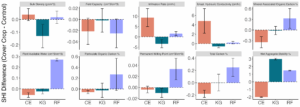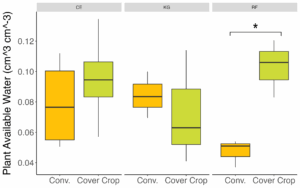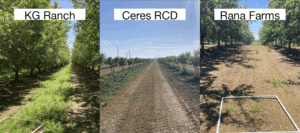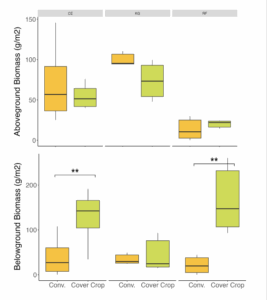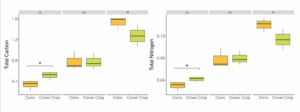Progress report for GW24-005
Project Information
Cover cropping has been demonstrated to be an effective conservation technique at combating soil degradation and restoring soil health. Unfortunately, California orchard growers have low rates of cover cropping due to management timing, costs, and concerns of competition with crops for resources, especially water. A hybridized cool season grass, Radix Poa bulbosa, commonly referred to as Oakville Bluegrass, presents a novel drought-tolerant, perennial cover crop designed for orchard systems. The project team will partner with working almond orchards in the California Central Valley to assess the impact of Oakville Bluegrass on a suite of physical and hydrologic soil properties during cover crop establishment. This research will address if the novel cover crop can bring improvements to water storage dynamics through structural changes and carbon inputs. Continuous soil moisture data will be collected in addition to water use efficiency of orchard trees to clarify perceptions of cover crop water use, addressing concerns that often lead orchard growers to maintain bare ground management. Collaborating almond growers will document operational changes linked to managing the cover crop. Field days, hosted on participating orchards, will showcase the soil health impacts of cover cropping with Oakville Bluegrass and offer technical assistance to growers. Research findings will be communicated through printed outreach materials and digital media in the form of a short video, blog, and podcast. This research aims to contribute to knowledge on soil health and water dynamics of perennial cover crops in semi arid, irrigated cropping systems of California.
Research Objectives:
- Evaluate the impact of perennial cover cropping on structural and hydrologic soil properties compared to bare ground management.
- Quantify changes in soil carbon pools from cover cropping and evaluate carbon inputs from cover crop biomass, ground coverage, and plant C:N.
- Examine the effect of cover cropping on soil moisture and plant water response of almond trees.
Educational Objectives:
- Create outreach materials to increase knowledge and awareness of the effect of cover cropping on soil health through: 1) a video showcasing soil management strategies using a rainfall simulator demonstration, and 2) an illustrated fact sheet about perennial cover cropping with Oakville Bluegrass.
- Demonstrate the soil health and management impacts of perennial cover cropping compared to bare ground management through two field days hosted at a participating producer’s orchard.
- Communicate findings through 1) co-creating an episode for the UC ANR Water Talk podcast, 2) presenting research at extension and grower conferences, and 3) publishing research in a peer-reviewed journal.
Cooperators
- - Producer
- - Producer
- (Researcher)
- - Producer
Research
This project builds on an NRCS Conservation Innovation Grant titled “Climate-Smart Irrigation for Drought, Fertility, & Structural Resilience in Almond Systems,” which established on-farm trials of Oakville Bluegrass across multiple commercial orchards in California’s Central Valley. Project team members—Kelsey Fenn, Dr. Mallika Nocco, Dr. Cristina Lazcano, and Jeff Borum—are collaborators on both the leveraged project and this grant, contributing to grower recruitment and trial implementation.
Research activities under this project are being conducted at three almond orchards participating in the Oakville Bluegrass trials. These sites span representative fine- and coarse-textured soils commonly found in the region (see Table 1 for site details). In fall 2023, Oakville Bluegrass was sown in the orchard alleys (tractor rows) at a seeding rate of 150 lbs per seeded acre. A control treatment—conventional bare ground management—was maintained in adjacent alley sections, reflecting grower-standard practices such as herbicide application and mowing.
Two of the orchard trials follow a randomized complete block design, with three to four replicate blocks of both the cover crop and control treatments. The third site was implemented as a split-orchard design (cover crop vs. control sections), with multiple observations per treatment to allow for pseudoreplication. Growers provided input on trial layout and sampling logistics to ensure compatibility with site-specific management and operations.
Table 1. Orchard site information for participating orchards in this study.
|
Site |
Grower |
County |
Acreage |
Soil Series |
Soil Texture |
Age of orchard by 2024 season |
Variety |
|
TriNut, Westley |
Nav Athwal |
Stanislaus |
90 |
Zacharias |
Clay loam |
4 |
Shasta |
|
KG Ranch |
Zac Ellis |
Madera |
50 |
El Peco-Dinuba |
Fine sandy loam |
7 |
Nonpareil mix |
|
Rana Farms |
Jasvir Rana |
Placer |
50 |
Redding / Corning |
Gravelly loam |
8 |
Nonpareil mix |
|
TriNut, Ceres |
Nav Athwal |
Stanislaus |
50 |
Dinuba |
Sandy loam |
2 |
Nonpareil mix |
Research Objective 1: Evaluate the impact of perennial cover cropping on structural and hydrologic soil properties compared to bare ground management.
Two replicate samples were collected and subsampled at two depths (0–15 cm and 15–30 cm) within each treatment plot. Bulk density was determined using the intact core method1. Gravimetric water content and aggregate stability were analyzed on bulk samples. Aggregate stability was assessed using two complementary approaches: (1) a standard wet-sieving method for water-stable aggregates2, and (2) a slaking index quantified via image analysis3—a method endorsed by the Soil Health Institute for its accessibility and comparable sensitivity to management practices.
Surface and subsurface compaction were measured using a handheld cone penetrometer and corrected for field soil moisture4. These metrics directly assess whether Oakville Bluegrass contributes to improved soil structure—by increasing aggregation, reducing surface hardness, and enhancing bulk density through greater root density and groundcover.
To evaluate soil water storage dynamics, plant available water (PAW) was measured using pressure plate extractors on the intact cores5. PAW was calculated as the volumetric water content difference between field capacity (-33 kPa) and permanent wilting point (-1500 kPa).
In fall 2024, water infiltration was measured using a tension disk infiltrometer at two locations per treatment block at each orchard. These infiltration tests were conducted prior to the onset of winter rainfall to assess treatment effects on saturated hydraulic conductivity and water movement. These physical and hydrologic measurements collectively address whether cover cropping improves soil water retention, infiltration, and overall plant-available water capacity compared to bare ground management.
To assess treatment effects, ANOVA was used to test for differences in individual soil health indicators between cover crop and control plots, followed by post hoc pairwise comparisons. Given that orchard soil properties evolve over time due to perennial crop management, we focus on comparing treatment differences within each sampling year rather than referencing static baseline measurements. We also tested for site-level interactions to account for variability in soil type and grower practices.
In spring 2025, the second year of sampling was completed across all three orchard sites using the same field methods as the previous year. Laboratory and statistical analyses are currently underway.
Figure 1. A diagram of the physical soil measurements and plant samples taken per block of each participating orchard. Measurements and samples will be collected in the middle of the alley at least 4 feet from the berm.
Research Objective 2: Quantify changes in soil carbon pools from cover cropping and evaluate carbon inputs from cover crop biomass, ground coverage, and plant C:N.
During the spring 2024 field sampling events described under Research Objective 1, 80 plant biomass samples were collected from orchard alleys at peak Oakville Bluegrass growth to assess above- and belowground organic matter inputs. In each plot across the three orchards, a 0.1 m² quadrat was used at two sampling points to collect aboveground cover crop biomass or any existing vegetative groundcover. This method was recommended by the technical team at Vitidore, Inc. To quantify the area of groundcover, photographs were taken at each sampling point and processed using Canopeo, a mobile application that calculates percent canopy coverage from digital imagery6. Belowground biomass was collected by compositing four soil cores (0–30 cm) per aboveground biomass location, capturing the soil depth where most Oakville Bluegrass roots are concentrated. Roots were extracted using a root washing protocol, and fresh and dry weights were recorded separately for above- and belowground biomass.
To characterize the biochemical properties of the plant material, a subsample of aboveground biomass was ground and analyzed for total carbon and nitrogen content. These analyses were performed at the UC Davis Analytical Lab using combustion methods. Because plant C:N ratios reflect physiological traits unlikely to vary significantly across years, these measurements were only conducted in Year 1.
Bulk soil samples collected for Objective 1 were also used to assess changes in soil carbon pools. Subsamples were ground and analyzed for total carbon and nitrogen via elemental combustion analysis7. With another subsample, soil organic matter was fractionated into particulate organic matter (POM) and mineral-associated organic matter (MAOM) using physical separation via wet sieving8. These fractions were also analyzed for carbon and nitrogen content to provide insight into the size and composition of soil organic matter pools.
This approach enables differentiation between labile (POM) and stable (MAOM) carbon pools. While MAOM is relatively slow to respond to management changes, POM—primarily composed of plant residues—is more sensitive to inputs from cover cropping. Changes in the POM fraction over the first two years of cover crop establishment may signal early indicators of carbon sequestration potential under perennial cover cropping.
Research Objective 3: Examine the effect of cover cropping on soil moisture and plant water response of almond trees.
Before the start of the second growing season of Oakville Bluegrass (early Fall 2024), continuous soil moisture monitoring was initiated to evaluate how cover cropping influences soil water dynamics under orchard alleys. TEROS 12 soil moisture sensors were installed at two project orchards in both cover crop and conventional plots, positioned at 15, 30, and 45 cm depths within the center of the alley rows. These sensors measure soil moisture and temperature via dielectric permittivity and were connected to in-field data loggers programmed to record data hourly.
At the third orchard site, sensor installation was not feasible due to high clay content and subsurface rock, which prevented proper sensor placement. However, this grower has existing soil moisture monitoring infrastructure installed by a third-party vendor. These data will be used to supplement baseline soil moisture for this location.
Sensor placement was coordinated with each grower to avoid interference with orchard operations and ensure long-term data reliability. The resulting data stream is now being processed and will be used to calculate a cover crop soil moisture ratio—a metric comparing volumetric water content under cover crop versus bare ground treatments across time. This ratio will identify when and how often soil moisture levels differ between management strategies.
In addition, fractional soil moisture will be calculated at the start of the almond growing season, defined as the proportion of moisture remaining in the soil relative to peak winter saturation. This metric is especially relevant for growers, as it provides a basis for timing the initiation of irrigation based on residual soil water storage. Together, these analyses aim to quantify the water-use implications of perennial cover cropping in almond systems and inform conservation-oriented irrigation management.
Research Objective 1: Evaluate the impact of perennial cover cropping on structural and hydrologic soil properties compared to bare ground management.
Following the first growing season, structural soil properties showed early signs of improvement under perennial cover cropping in the surface layer (0–15 cm). While no changes were observed at the 15–30 cm depth, cover crop plots trended towards lower bulk density at two of the three orchards (Rana Farms and Ceres RCD), suggesting that even in the first year, root activity and surface groundcover may begin to influence compaction. The third orchard, KG Ranch, showed slightly higher bulk density under cover cropping, highlighting the influence of site-specific factors such as soil texture and previous management history. Measures of soil aggregation (wet aggregate stability and slaking index) did not show significant differences between treatments after the first season. However, these indicators often require multiple seasons to detect shifts, especially in perennial systems. Most soil health indicators did not follow the same trends across all sites, pointing to site specific responses to cover cropping practices (Figure 1).
Figure 1. Difference in soil health property means from cover cropping compared to conventional management for each site. Error bars show standard error.
Encouraging trends emerged in hydrologic soil properties, with infiltration rates trending higher under cover cropping at both the Ceres RCD and KG Ranch sites. The most notable improvement was observed at Rana Farms, where plant available water was significantly higher under cover cropping (Figure 2), pointing to enhanced soil water retention in response to changes in groundcover management.
Figure 2. Plant available water capacity under cover crop and conventional management across all three sites. Error bars show standard error and significant differences (p < 0.01) are denoted with an asterisk.
Together, these early findings suggest that improvements in soil physical properties may emerge over time, and that inherent site characteristics play a significant role in how soil responds to cover cropping. Continued monitoring over multiple growing seasons will help confirm these promising trends.
Research Objective 2: Quantify changes in soil carbon pools from cover cropping and evaluate carbon inputs from cover crop biomass, ground coverage, and plant C:N.
Cover crop establishment varied across field sites in year one, offering valuable insight into the management and environmental factors that influence successful integration of perennial species in almond orchards. Early growth patterns appeared to be influenced more by microclimate and soil moisture availability than by broader climatic gradients (Figure 3).
Figure 3. Photographs of Oakville Bluegrass in cover crop plots at field sites taken at the time of sampling in April 2024.
At Rana Farms, cover crop emergence was minimal. After consultation with the grower, it is likely that residual effects from a pre-emergent herbicide applied two years prior contributed to poor germination. In contrast, KG Ranch achieved the highest overall cover crop biomass. The Ceres RCD site showed early dormancy in the cover crop, likely triggered by the combination of young tree age (limited shading), sandy soils, and photosensitivity of Oakville Bluegrass, which is programmed to respond to changing daylight hours.
Despite site-to-site variability, cover crop plots generally provided more consistent and evenly distributed ground cover than control plots, which featured variable growth of unmanaged resident vegetation. While some control plots yielded higher biomass than their cover crop counterparts, this biomass was often patchy and less reliable as a soil cover.
Dry biomass data from all three sites (Table 2) highlight the potential for high belowground biomass contributions in the cover crop plots, especially at Rana Farms, where root biomass under cover cropping was significantly greater than in control plots (Figure 4). This indicates early potential for carbon inputs belowground, even where aboveground growth was limited.
| Field Site |
Cover Crop Shoots (kg/ha) |
Cover Crop Roots (kg/ha) |
Resident Vegetation Shoots (kg/ha) |
Resident Vegetation Roots (kg/ha) |
| Rana Farms |
202 ± 47 |
1670 ± 760 a |
135 ± 135 |
213 ± 198 b |
| Ceres RCD |
546 ± 156 |
1277 ± 625 |
712 ± 496 |
405 ± 452 |
| KG Ranch |
736 ± 230 |
442 ± 383 |
1000 ± 81 |
344 ± 116 |
Table 2. Dry biomass (mean +- SD) for vegetation in cover crop and control plots at each field site. Significant differences in biomass between groundcover practice are denoted by lowercase letters (p < 0.05).
Figure 4. Aboveground and belowground biomass from orchard alley groundcover under cover crop and conventional management across all three sites. Error bars show standard error and significant differences (p < 0.001) are denoted with two asterisks.
Aboveground C:N ratios varied by site and season. At KG Ranch, the cover crop biomass had a C:N of 23 at peak growth, consistent with healthy grass development. At Ceres RCD, the C:N ratio was lower (9.9), reflecting later-stage dormancy and potential nitrogen reallocation within the plant.
Soil carbon pool responses were still in the early stages after one growing season. At Ceres RCD, total soil carbon and nitrogen were greater under cover crop plots, suggesting early contributions to soil nutrient pools (Figure 5). No significant treatment effects were observed for particulate organic matter (POM) or mineral-associated organic matter (MAOM) across the sites, which is not unexpected given the time scale required to build measurable changes in soil organic matter pools.
Figure 5. Total carbon and nitrogen of soil under cover crop and conventional management across all three sites. Error bars show standard error and significant differences (p < 0.01) are denoted with an asterisk.
These findings underscore the importance of long-term monitoring for soil carbon outcomes, while also demonstrating how biomass allocation and groundcover quality vary by site and can inform future cover crop management strategies.
Research Objective 3: Examine the effect of cover cropping on soil moisture and plant water response of almond trees.
Continuous soil moisture data collection is underway for the second growing season of the cover crop (fall 2024–spring 2025) and is progressing according to the project timeline. These sensors are recording hourly data on soil moisture and temperature for a full year, providing a high-resolution dataset on water dynamics in the orchard alleyways.
While data analysis is ongoing, this effort represents a critical step in understanding the interaction between perennial cover cropping and water availability, a key concern for almond producers facing climate-driven shifts in precipitation and irrigation constraints. These insights will directly inform management recommendations in future project years.
Research outcomes
Initial results from the first year of this project indicate that while measurable improvements to soil health from perennial cover cropping may be limited in the short term, the practice shows promise for long-term benefits—particularly in a highly disturbed orchard alley with frequent equipment traffic. Despite the presence of resident vegetation under conventional management, belowground biomass of the cover crop was greater than resident vegetation in two of the three sites. Establishment of the cover crop root system is the first step in improving soil conditions. The use of Oakville Bluegrass as a perennial cover crop represents an important shift from annual to multi-season groundcover, offering a continuous soil-building approach that aligns with sustainable management goals.
Key recommendations based on research outcomes:
- Recognize that improvements to soil health often require multiple years to become detectable, especially in water-limited orchard systems of the Western U.S. The first year of cover cropping showed minimal changes in bulk density, infiltration, and carbon pools, which is expected given the slow rate at which soil structure and organic matter build up. However, early signals such as increased plant available water and positive infiltration trends at certain sites underscore the importance of maintaining cover crops across multiple growing seasons to allow benefits to accumulate.
- Leverage the advantages of a perennial cover crop system. Unlike annual cover crops that must be re-established each year, Oakville Bluegrass persists across seasons, minimizing soil disturbance, reducing replanting labor and cost, and supporting continuous root growth that contributes to soil aggregation, carbon inputs, and improved water dynamics over time. These perennial traits make it especially suitable for integration into permanent orchard systems.
- Tailor cover crop adoption to field conditions. Cover crop performance was closely tied to soil texture, moisture availability, and canopy cover. Successful establishment was highest at sites with finer-textured soils and moderate shading. Growers should consider these field characteristics when selecting sites for cover cropping, and research should continue exploring varietal and management options for more challenging environments.
- Improve control plot design and weed management for clearer comparisons. High weed biomass in control plots likely diminished the apparent differences in biomass and soil response between treatments. Future studies and on-farm trials should include better weed suppression in controls or explicitly compare perennial cover crops to bare ground.
- Continue and expand monitoring of soil moisture dynamics. Ongoing soil moisture sensor data will provide critical insight into how cover cropping affects water storage and availability during key stages of almond development. These results will directly support more efficient irrigation decisions in the face of increasing water restrictions under SGMA.
Education and Outreach
Participation summary:
The educational component of this project facilitates widespread knowledge sharing by targeting a diverse stakeholder portfolio through direct communication with orchard growers at extension events, indirect communication to growers and extensionists via multi-media outreach materials, and the sharing of results among the research community.
Educational Objective 1: Create outreach materials to increase knowledge and awareness of the effect of cover cropping on soil health through:
1) a video showcasing soil management strategies using a rainfall simulator demonstration, and 2) an illustrated fact sheet about perennial cover cropping with Oakville Bluegrass.
To extend our outreach to the wider agricultural community, especially those unable to attend in-person workshops, the project team has generated several multi-media outreach materials in line with the project timeline for educational objective 1.
Our primary endeavor involved the production of a short video by Dr. Moonilall and I where we demonstrated the tangible soil health benefits from ground cover using a rainfall simulator. The rainfall simulator, a widely used extension tool, visually illustrated the impact of soil erosion and infiltrability from rainfall events. The setup mimicked rainfall over a series of soil pedons (intact surface soil samples), each representing different structural properties or groundcover types. Water that infiltrated and percolated through the intact soil pedon was collected in jars to demonstrate water infiltration. Water that ponded and flowed off the soil surface was captured in separate runoff jars. Together, both the surface runoff and infiltration aspects of the rainfall simulator demonstrated the different impacts of each soil management strategy on the erosional process. During the demonstration, we simulated a rainfall event, after which, we showcased the amount of water collected in each jar and compared the effect of soil management practices under different ground cover types. The video was produced at the Ceres RCD, one of our participating grower’s orchards. Dr. Moonilall and I were featured in the video and filming and production was done by collaborators at the Almond Board. This straightforward yet powerful visualization highlights how groundcover plays a pivotal role in mitigating soil degradation. In the summer of 2024, this video was published online and shared directly with members of the Almond Board, the largest and primary almond grower association in the state.
In the fall of 2024, I produced an infographic to depict how cover crop roots create physical and chemical changes in the soil that lead to improved soil health and structure. This infographic was shared digitally over social media platforms, including LinkedIn and X. It was also printed and distributed at the Almond Board Conference in December 2024. To this extent, educational objective 1 was completed in this project year on time with the project timeline.
Educational Objective 2: Demonstrate the soil health and management impacts of perennial cover cropping compared to bare ground management through two field days hosted at a participating producer’s orchard.
As part of Educational Objective 2 in Year 1 of the project, we held a grower educational clinic in May 2024—delivered ahead of schedule to take advantage of a collaborative opportunity with Vitidore. The event was strategically scheduled during the end of the growth period of Oakville Bluegrass and co-organized with grower partner Nav Athwal. Together with Vitidore and Nav, our team designed a soil health-focused, half-day workshop centered on perennial no-till cover cropping in nut production systems.
The event took place at a demonstration orchard participating in this project, located adjacent to the East Stanislaus RCD Soils Center, where portions of the workshop were also held. While the clinic was tailored to nut producers, it attracted a diverse audience that included extension specialists, technical assistance providers, and researchers. We structured the program into three segments, each aimed at highlighting both the practical and research-driven aspects of groundcover management.
Part 1: I opened the workshop with a presentation on Oakville Bluegrass, highlighting its role as a perennial cover crop and comparing it to annual cover cropping strategies. I shared project hypotheses and research objectives focused on its impact on soil physical health in almond orchards. To demonstrate soil structure improvement, I conducted a hands-on aggregate stability test using soil samples from both cover-cropped and conventionally managed plots. Andrew Gal, a collaborating graduate student, followed with a presentation on methods used to quantify the cover crop’s consumptive water use, including eddy covariance towers and remote sensing technologies.
Part 2: Grower collaborator Nav Athwal and vineyard farmer Al Wagner led an interactive discussion on successful cover crop establishment and management. They shared firsthand experiences and fielded questions from attendees about the challenges and opportunities of working with Oakville Bluegrass and participating in the cooperative.
Part 3: Mike Morgenfield from the Oakville Bluegrass Cooperative guided participants on a field tour, comparing alleys managed with Oakville Bluegrass to those under bare ground management. This walk-through fostered further discussion on implementation strategies and allowed the project team to provide targeted technical assistance for installing and maintaining perennial cover crops.
The second field day for educational objective 2 will be delayed due to temporary pauses in project spending during the winter, which delayed our planning timeline. Our key collaborators at Vitidore were similarly affected by funding freezes of their own, impacting joint preparations. As funding has resumed, we are actively planning for the next field day. To ensure the most effective demonstration of cover crop performance, we are now targeting the next growing season, when the cover crop will have reemerged.
However, we maintained grower engagement by participating in two webinars focused on groundcover management and water use in California perennial systems in the fall of 2024. I presented on Oakville Bluegrass as a soil health management strategy and its potential to support on-farm conservation. These events, hosted by the Oakville Bluegrass Cooperative, were designed to reach a broader grower audience across the state—one targeting almond growers and the other targeting wine grape growers. The virtual format allowed us to connect with growers who may not have been able to attend an in-person field day, thereby extending our outreach impact.
Educational Objective 3: Communicate findings through 1) co-creating an episode for the UC ANR Water Talk podcast, 2) presenting research at extension and grower conferences, and 3) publishing research in a peer-reviewed journal.
Year 1 goals for Educational Objective 3 were completed as planned. I presented a research poster highlighting our first-year findings at the California Climate and Agriculture Summit—a prominent statewide event hosted by the California Climate and Agriculture Network. The summit convenes a diverse audience of producers, researchers, and policy professionals, and this year’s program emphasized water conservation in the context of the Sustainable Groundwater Management Act (SGMA) and strategies for enhancing on-farm resilience. Our project’s research focus on soil health and water conservation aligned strongly with the summit’s themes. Throughout the event, I engaged in numerous productive conversations with nut growers and other producers from across California, generating interest in our findings and laying groundwork for future collaboration and outreach.
Our outreach efforts revealed both opportunities and challenges in effectively engaging growers. Recruiting almond growers to attend in-person field days proved difficult, despite targeted outreach. However, during the field day itself, grower participants were notably more engaged when producer collaborators led discussions. Attendees asked more questions directly to fellow growers than to the research team, highlighting the value of peer-to-peer learning in agricultural extension.
The orchard walk-through—where attendees could observe the Oakville Bluegrass cover crop in the field—was a particularly effective component. This hands-on experience spurred more in-depth conversation and engagement than the indoor presentations, suggesting that experiential learning plays a critical role in knowledge transfer for this audience.
In follow-up conversations, many growers expressed that virtual workshops were a more feasible option for their schedules. However, participation in webinars was lower than anticipated: 11 growers registered for the almond-focused webinar (4 attended), and 22 registered for the wine grape webinar (14 attended). While these virtual events expanded geographic reach, they generated fewer questions and less interaction than the in-person event, reflecting the limitations of online formats for fostering discussion and building rapport.
Additionally, informal grower engagement during spring sampling visits proved highly valuable. These field meetings allowed the project team to better understand on-the-ground management challenges and adaptations related to perennial cover cropping. They also provided an opportunity to offer direct technical support and reinforce best practices to help ensure trial continuity and long-term success of the cover crop installations.

